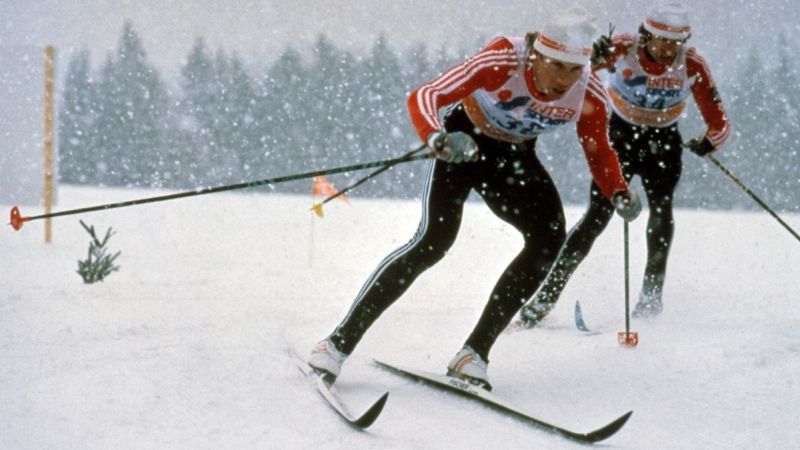
From the Archive: Flipping the Switch, The Birth of Skating
Boulder Nordic & Cycle Sport Staff
This article first appeared in the 2019/2020 edition of the BNS Magazine. To celebrate (what could be argued as) the 40th birthday of the skating technique, we're bringing out again. Enjoy!
For nordic skiers who came to the sport within the last thirty years, there is a real chance that they’ve always known classic and skating techniques. That wasn’t always the case. In fact, depending on how you measure it, “skate skiing” hasn’t yet celebrated its fortieth birthday. And, if skating did have a birthday, it would be January 17, 1985. Its formal name: Freestyle.
As early as 1982, glimpses of freestyle skiing showed up on the international stage in the form of the “marathon skate.” Bill Koch was a notable early adopter of the technique when he won the overall World Cup of that year. The skiing community didn’t quite know what to make of it all. Marathon skating in the wrong part of a racecourse could result in disqualification. All of this changed, though, at a single coaches’ meeting immediately preceding the first race at the 1985 World Championships.


Conditions in Seefeld, Austria, were tricky in January of 1985. The weather was hovering just around freezing, and the snow was old and dirty. These factors made using grip wax very challenging, and every race used grip wax. Always. The challenge was this: Warm snow calls for sticky grip wax. Sticky grip wax picks up dirt quickly. Dirty grip wax makes for slow skis.
At the coaches’ meeting ahead of the first race, the possibility was floated to use “freestyle” technique. That is to say, athletes would be free to propel themselves around the course by whatever means they wished, without any technique limitations. This was something utterly unprecedented in international competition.
In order to mandate the use of what is now known as “classic” technique (and use of grip wax), the decision among the coaches would have to be unanimous. Australia cast the first vote in favor of allowing athletes to use any technique. U.S. Ski Team coach Mike Gallagher voted in favor, too. So did everyone else. The entire 1985 World Championships would be “freestyle.”
Skating had been born.
The next day, the men’s field lined up for the world’s very first freestyle competition, a 30k. Few skis, if any, had grip wax applied. Most athletes had never trained for anything like it; the Norwegian coaches had even promised their skiers that there would not be skating in Seefeld. Suddenly, long ski poles became so scarce the day before the race that teams had to prioritize which athletes received freestyle-length poles— suppliers simply couldn’t provide enough. At the end of the event, though, the best athletes still won, including Gunde Svan and Anette Bøe.
Every race day was a new experience for athletes, coaches, and ski techs. After each competition, the coaches would go out on the racecourse to learn as much as possible before the next competition day. For instance, after the first races, there were herringbone tracks on every climb, just like traditional classic technique. Later in the week, there were signs that the racers were gliding, slightly, between each climbing step. This would eventually evolve into what we know in the U.S. as V1, a powerful climbing technique.
The Seefeld World Championships concluded with a very snowy men’s 50k on January 27, and nordic skiing has been different ever since. Previously, there had been debate as to whether skating would be something to reckon with.
Now, there was no question. The switch was flipped.
The summer of ‘85 also saw the emergence of V2 technique as athletes were training on glaciers. Of course, it wasn’t called V2 yet. Skating technique names emerged when the U.S. Ski Team coaches met with a biomechanics expert at the University of Pennsylvania to further develop freestyle technique. Among other things that emerged from those meetings, the skating technique names that are still used today were determined: V1, V2, and V2 alternate.
Because of the rapid development of skating and the stage on which it was set, the vast majority of freestyle knowledge in the U.S. was held by the U.S. Ski Team coaching staff. In the fall of ‘85, a coaches’ education program was put into place to start the spread of this new technique.
By 1987, classical and freestyle techniques had become distinctly different, as reflected in competitions around the world. Equipment was evolving at a rapid pace as well. Not all of the ideas worked out. Fischer’s first skate skis had metal edges that performed poorly in cold weather. Poles got just a bit too long. The successes and failures alike, though, helped move the sport forward. Skis got shorter and stiffer with lower tips. Boots became stiffer, and cuffs began to appear. Pure fluorocarbons, in the form of Swix’s Cera F, were introduced in 1987, too. But that’s a whole other story.
Equipment and technique continued to evolve, though perhaps at a slower pace. Then, in the early 2000s, equipment began another rapid evolution. New materials and engineering breakthroughs allowed skis, poles, and boots to become ever-lighter, faster, and more efficient. Skating technique, too, continued to evolve in order to find more power and efficiency. Gone are the long strides and follow-through; movements have become shorter, and turnover is higher.
Looking back at all that has transpired over the past 35 seasons, it is hard to ignore the role that the 1985 World Championships played in the development of freestyle. Had there been cold weather and fresh new snow, who knows, perhaps we’d still be marathon skating.
But only now and then.



